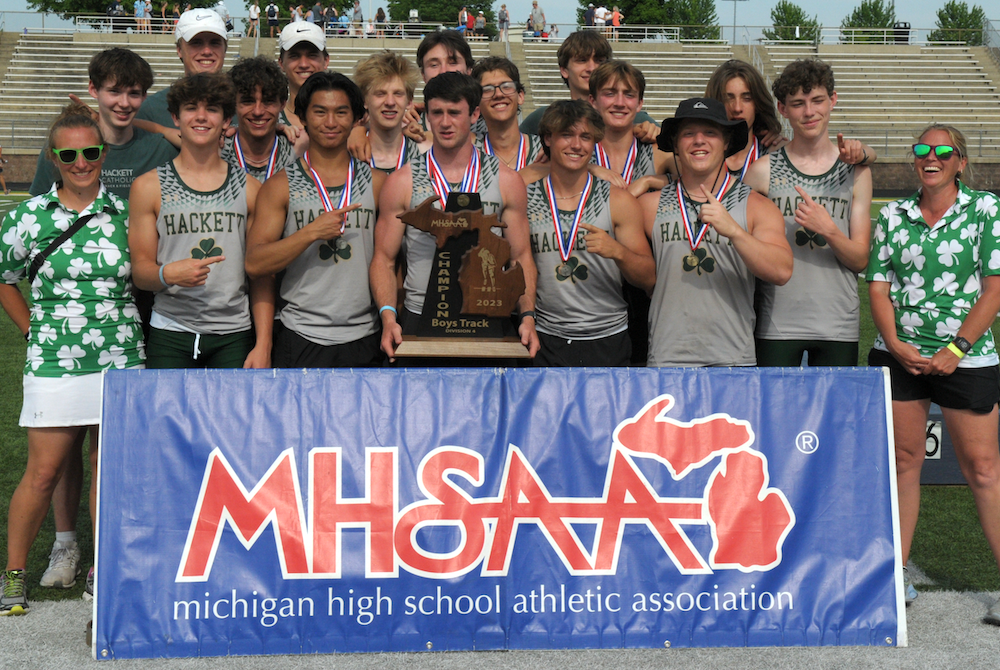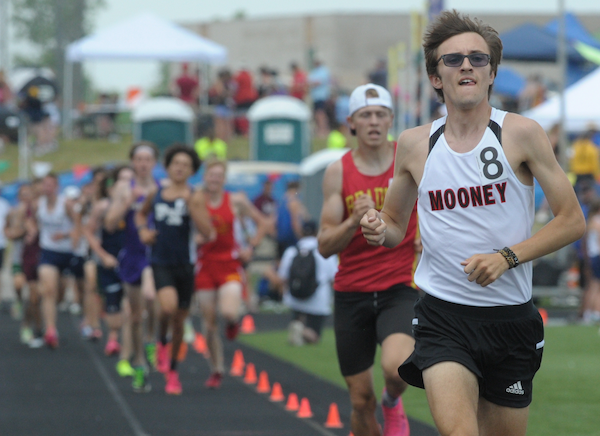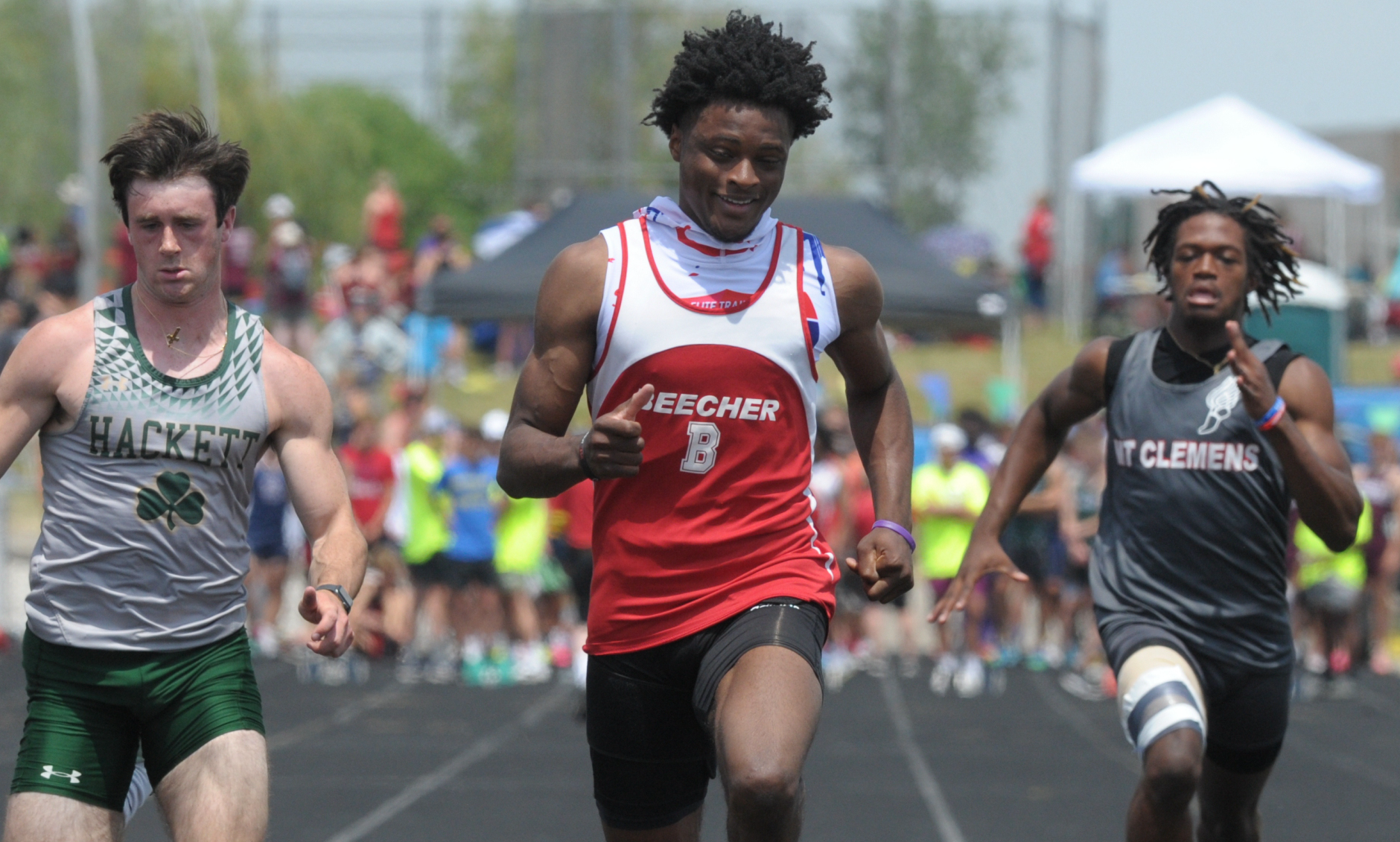
After Close Calls, Chelsea Claims Title
June 1, 2013
By Greg Chrapek
Special to Second Half
ADA – This spring’s high school sports season long will be remembered for having some of the worst weather in years.
While the wet and cold weather hampered many teams across the state, the Chelsea boys track team used it to its advantage. And the payoff was an MHSAA Lower Peninsula Division 2 track and field championship Saturday afternoon at Forest Hills Eastern.
After coming close the past two years, the Bulldogs came away with this year’s title as they totaled 64 points to edge second-place Grand Rapids Ottawa Hills by eight points.
Chelsea finished second two years ago, and last year the Bulldogs placed third. This year, thanks to some hard training when the weather was at its worst in the spring, Chelsea had what it took to bring home the title hardware.
“Back in March and April when the weather was bad and everyone was complaining about how bad the weather was, we talked about just concentrating and working harder,” Chelsea coach Eric Swager said. “Rain, sleet or snow everyone was out there working their hardest, and it paid off. … Everyone just worked that much harder when the weather was bad.”
The hard work resulted in Chelsea having a deep team capable of scoring points in a variety of events.
“Everybody contributed,” Swager said. “The sprints, the relays, the distance runners, field events. The entire team has been focused and working hard from day one. We have some individual talent, but everybody stuck together and that was the key.”
Berkley Edwards was one of the individual talents that helped pave the way for the Bulldogs. One of the state’s top sprinters, Edwards wrapped up his high school track career by winning both the 100 and the 200-meter dashes.
Edwards turned in a time of 10.58 in the 100-meter dash and then came back to edge Gary Jones of Allegan in a 200-meter dash that came down to the end. Edwards finished with a time of 21.37.
“Things went well for me today, better than expected,” Edwards said. “I ran a 10.58 which was a p.r. (personal record) in the 100, and then I ran a 21.37 which was a p.r. in the 200.”
The highlight for Edwards was holding on to win the 200.
“It was definitely a photo finish,” Edwards said. “It was a real close race. My strategy was to get out to the lead and hold it on the curve. I heard him (Jones) coming. I didn’t want to stress. I just stay relaxed.”
Sweeping both the 100 and 200 was a major key to Chelsea’s title and part of the strategy going into the Finals.
“My coaches told me I had an opportunity to win two races,” Edwards said. “They thought I could get the 100 and possibly the 200, and if I did we had a real good chance of winning.”
The Bulldogs also picked up points in the field events as senior Michael Hovater won the pole vault by clearing 14 feet, 10 inches. Chelsea also won the 3,200-meter relay as the team of Zach Rabbitt, Jacob Stubbs, David Trimas and Tony Vermilye turned in a time of 7:55.84.
Chelsea was pushed for the title by an Ottawa Hills team that had one of its best Finals performances in recent history. Key to Ottawa Hills’ strong effort was the performances turned in by its sprint relay teams.
Ottawa Hills finished in the top three of three of the four relay events, led by the first-place 400-meter relay team of Shawn Kneeland, Sam Beal, Jacori Millbrooks and Teyland Avery.
 The relay was seeded second coming into the day but came away with the school’s first title-winning effort at the Finals since 1997.
The relay was seeded second coming into the day but came away with the school’s first title-winning effort at the Finals since 1997.
“This was real big,” Kneeland said. “The key for us was to focus. Not to worry about anyone else and just focus on running our best.”
Senior Teyland Avery ran the anchor leg for the Bengals.
“To win a state title in Grand Rapids was real special,” Avery said. “We had two seniors on the relay team, and to finally win a title is special. Last year we finished third at state and we didn’t do too well. This just feels great. To run in my city and to win in my city is pretty special.”
For Detroit East English senior Marcell Wyckoff and the rest of his teammates, Saturday’s Finals were the first in school history as East English is in its first year as a high school. Wykoff, who came in seeded second, won the 400-meter dash.
“The first thing I wanted to do was to get out fast,” Wykoff said. “I knew if I got out to a good start, nobody would catch me. I had a pretty good start, and I held on.”
Wykoff’s title was the first in school history and was a little bittersweet for the senior.
“I came over from Crockett Tech,” Wykoff said. “This year was really different. It was not like I thought my senior year would be, but it ended up pretty good winning a state championship. It feels good on the inside.”
Mason senior distance runner Tanner Hinkle ended a few years of frustration both on the track and during cross country season. He won the 3,200 by more than four seconds with a time of 9:13.41.
“I have finished second two different times at state,” Hinkle said. “Winning it my senior year feels real good, to finally win a state title. I also finished second at state during the cross country season. I’ve been very close to a state title a few times before, and to finally win one is a dream come true.”
In the field events, Cadillac senior Riley Norman closed out a successful high school throwing career by winning the shot put for a second consecutive season. He turned in a winning put of 59-10, missing a Finals record by less than two feet.
“I won it last year with a 61-2 ½ and this year I had a p.r. of 62-10,” Norman said. “I wanted to set a new record, but I came up a little short.”
PHOTOS: (Top) Chelsea's Berkley Edwards races toward the finish line on the way to winning one of his two MHSAA titles Saturday. (Middle) Mason's Tanner Hinkle sets the pace in the 3,200. (Photos by Greg Chrapek.)

Thrower Claims Lone Individual Title to Lead Hackett to Team 3-Peat
By
Tom Lang
Special for MHSAA.com
June 3, 2023
Kalamazoo Hackett Catholic Prep just keeps winning and winning.
This time the Irish took home their fourth title in the last five Lower Peninsula Division 4 Track & Field Finals, on Saturday at Hudsonville.
Hackett’s only individual title was taken by discus winner Nathan Buchmann, a senior, who was fine knowing he was the shortest in stature among all the sizable competitors.
“In the offseason after football I worked out every day, working towards this goal,” he said after getting his medal. “I would say this takes 80 percent technique and 20 percent strength to throw the discus. So, length can help but if you have good technique and are really strong, that will play into it.
“I think we are very balanced throughout the meet today,” he said about teammates that scored points in finishes other than first place. “We have 13 guys here today, and we have people in a lot of the races. But I do not run; I have too short of legs to be a fast runner,” he said with a chuckle.
Buchmann had to work through a hip injury to compete this spring.
“I think the setbacks are what make you strong,” he said. “You can either give up through the setbacks or push forward and become better.”
 Coach Charissa Dean agreed.
Coach Charissa Dean agreed.
“The kids have big hearts,” she said after all the points were totaled and the Irish were on top once again, with 53. “They worked hard. They had a lot of potential when we started the season. And we had a lot of drive to put in the work, and we are happy the results came out the way they did.”
Reading was runner-up at 47 points, followed by Wyoming Potter’s House Christian with 42, then Fowler and Flint Beecher each with 37 points.
Senior Lezawe “Moses” Osterink, of Potter’s House Christian, placed second in 1,600 but took the 3,200 title as defending champ of both. He dominated the latter by lapping the field with a final lap kick that resembled more of a superhero speedster.
“Nobody really took it out that hard at the start,” he said. “There was a freshman (Marek Butkiewicz of Hackett) that tried to get the pace going quick, but me and Dakota (Dykhuis of Montabella) just kind of sat back and gradually pulled him through.
“We took it gradually, and I was just relying that I could kick.”
Kick did he ever. The trio were neck and neck the majority of the race in a grouping ahead of the pack.
“With 400 to go I just tried to go all out,” Osterink said. “I had a lot more left than I thought and I was pleased with the win. Not really the time, but that doesn’t matter, especially this hot out.”
The overall meet was in the low 90s/high 80s heat and searing sun all day. So, race officials allowed the unique opportunity for coaches to spray the runners with water and give them water bottles.
“It was very weird because I’ve never taken water to drink while I’m running, so I didn’t know how that would feel,” Osterink said. “And they were spraying us and hitting us in the face. It was kind of fun.”
Junior Tyler Lenn of Marine City Cardinal Mooney defeated Osterink at his own game in the 1,600.
“I’m feeling great,” Lenn said after grabbing the medal. “I said to a newspaper after one of my races (during the season) I was right where I wanted to be. This has been a long rebuilding process for me since an injury back in the fall, and I set a pretty high goal the day the injury happened. I was telling myself I needed to fulfill what I said I would do at the beginning of last cross country season. And that is what I did today.”
Lenn suffered an ankle sprain from a misstep that turned worse because he kept running through the season on it.
“Coming back from that was pretty tough, but I wouldn’t have it any other way,” he said.  “Perseverance; I said from the beginning what I was going to do. I kept my eye on that target, and no matter the circumstances life threw at me, that I was going to make it happen and I am a man of my word.”
“Perseverance; I said from the beginning what I was going to do. I kept my eye on that target, and no matter the circumstances life threw at me, that I was going to make it happen and I am a man of my word.”
Jaylin Townsend, a senior from Flint Beecher, dominated the short races. He won the 100 dash (10.67) and 200 dash at 22 seconds flat. It was his third 100 win at a Finals.
“I put in a lot of work; I had to three-peat,” he said after the 100. “There’s a lot of great competition here, so I knew I had to come out and run my best.”
Concord in the 400 (43.72), Buckley in the 800 (1:30.76) and 1,600 (3:29.13) and Potter’s House in the 3,200 (8:14.18) were relay champs Saturday. Reading’s Tayshawn Bester won the 110 hurdles (15.13), and Athens’ Landen Bennett won the 300 (39.85). Caseville’s Nathan Feltner won the 400 (50.76), and Vestaburg’s Owen Patton claimed the 800 (1:55.11).
Fruitport Calvary Christian’s Bradley Richards won the high jump (6-10), and Peck’s Alex Affer won the long jump (23-4). McBain Northern Michigan Christian’s Isaac Bowden was first in pole vault (13-0), and Brown City’s Kyle Affer won shot put (49-2).
PHOTOS (Top) Kalamazoo Hackett Catholic Prep celebrates its third-straight LPD4 title Saturday. (Middle) Cardinal Mooney's Tyler Lenn, far right, sets the pace in the 1,600. (Below) Flint Beecher's Jaylin Townsend, middle, crosses the finish first for one of his two sprint championships. (Photos by Ken Swart/RunMichigan.com.)

